

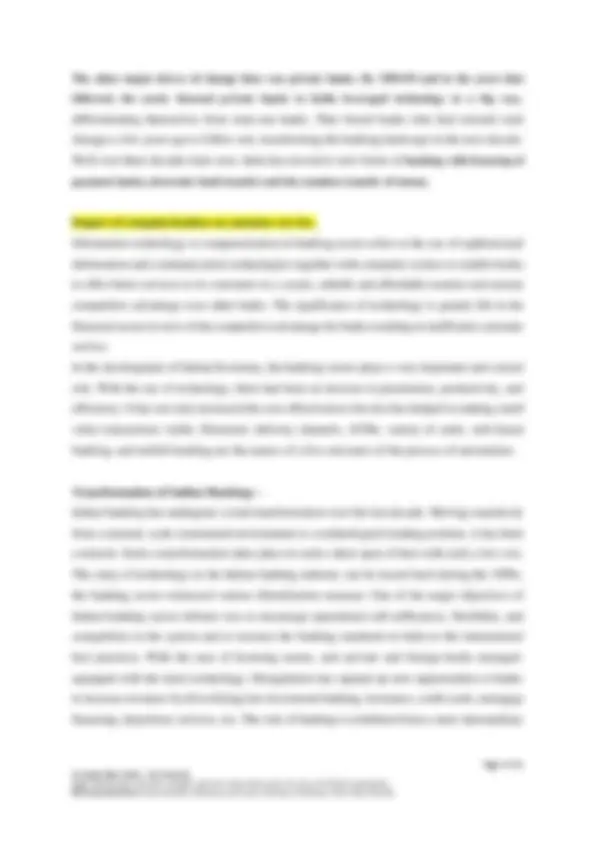
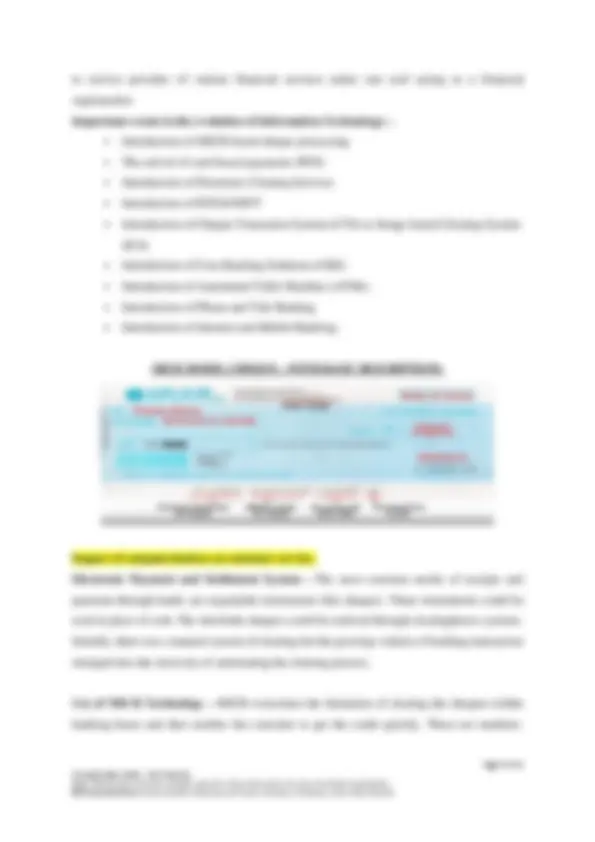
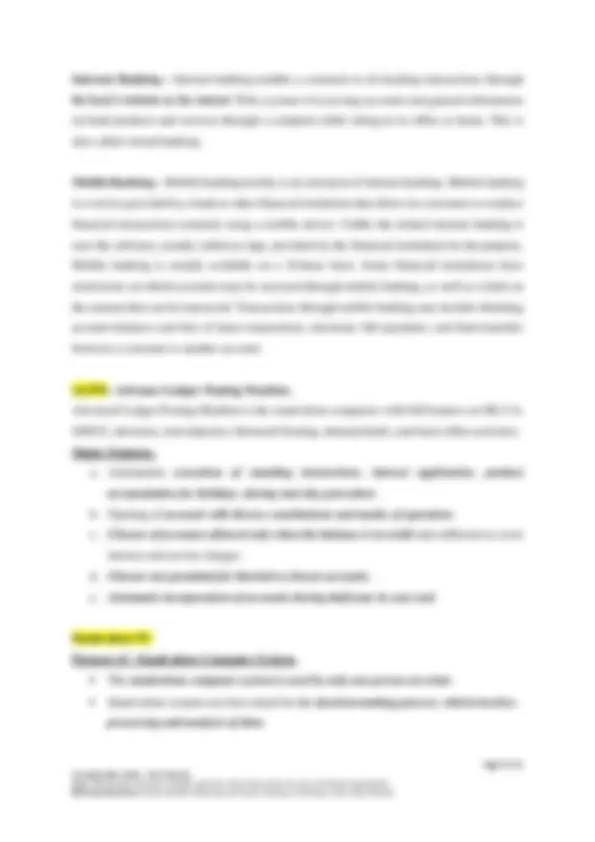
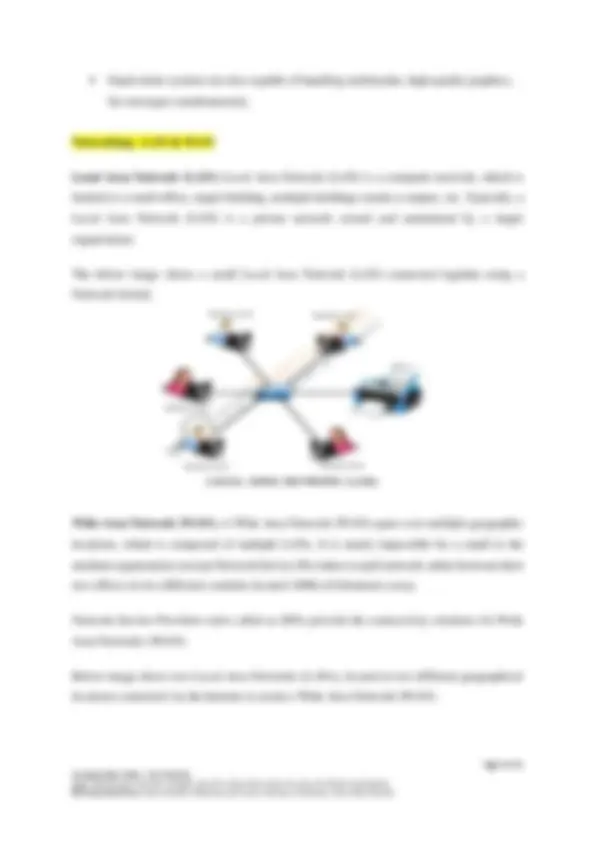
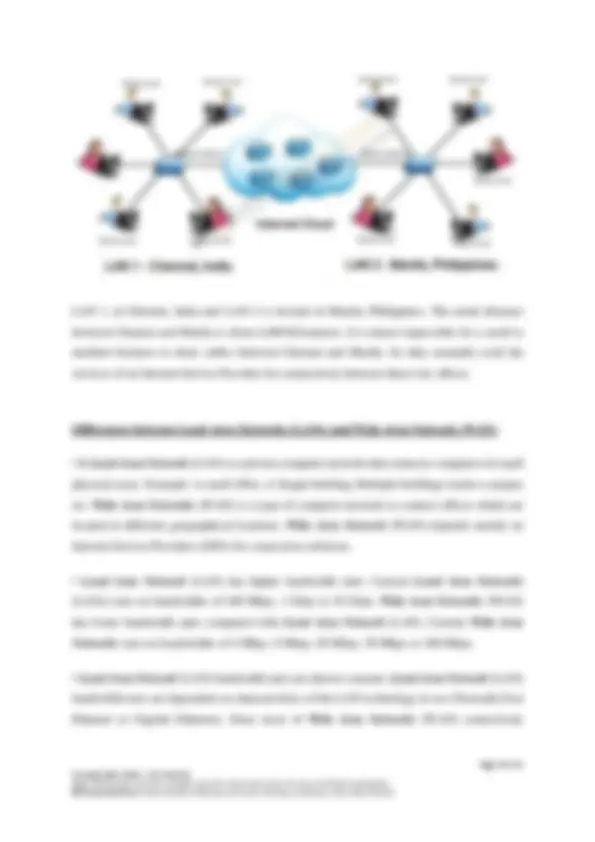


Study with the several resources on Docsity

Earn points by helping other students or get them with a premium plan


Prepare for your exams
Study with the several resources on Docsity

Earn points to download
Earn points by helping other students or get them with a premium plan
Community
Ask the community for help and clear up your study doubts
Discover the best universities in your country according to Docsity users
Free resources
Download our free guides on studying techniques, anxiety management strategies, and thesis advice from Docsity tutors
Notes in the form of examination point of view
Typology: Study notes
1 / 11

This page cannot be seen from the preview
Don't miss anything!







Page 1 of 11 Compiled Base Notes – For Students. Note: Student must refer the examples and class observation notes for class tests/final examination.
(BASIC NOTES – MUST BE READ ALONG WITH CLASS OBSERVATION NOTES) Introduction. The concept of Bank Automation/mechanization/Computerisation (Presently) in India practically started after 1980-81 and more precisely gained pace in the year 1983-84, after setting up a committee in the year 1983 under the chairmanship of the then Deputy Governor of RBI, Dr C. Rangarajan. Need for Computerisation. The five major objectives of computerization in banking are to improve: (a) Customer Service. (b) Maintenance. (c) Decision-making. (d) Productivity and (e) Profitability. Initiatives of RBI, CVC, GOI towards Mechanization / Computerization. For General Knowledge – related to Automation and computerization (Past Scenario- Article 1 for practical knowledge building). A Bird’s Eye View. How computerization was pushed in Indian Banking?
Page 2 of 11 Compiled Base Notes – For Students. Note: Student must refer the examples and class observation notes for class tests/final examination. Well, obviously there is a lot of excitement these days around technology in Indian banking space. However, how did this process actually start? – (Refer to the below article). A nice article which looks at this history of introducing computers in banking. It was a process that started around 1982, contrarian to most who would think it started post- 1991 (LPG Period). Actually, much of changes in Indian economy started around the 1980s (some say 1970’s around Emergency) and 1991 is just that time when all these things came together and became more reinforced due to LPG move by the GOI. Article: A few months after Manmohan Singh took over as RBI Governor in September 1982 , in a reshuffle of portfolios, one of his deputy governors, C Rangarajan, who had joined a little earlier during the previous governor IG Patel’s tenure , was assigned the responsibility of some of the major operational departments within the central bank, including monetary policy and exchange rate management. Rangarajan, who had taught at IIM Ahmedabad for long, had virtually little to do during the Patel days , with no core functional responsibilities in the first half of 1982 , but that changed when Singh took over. One of the primary issues Singh took up was the computerization of banking operations. He knew that there would be resistance to the change from unions and staff and so, told them that given the pace of global growth and technological advancement, mechanization was inevitable. Those were the days of enormous delays in cheque clearances , with money taking weeks to get credited to the accounts of customers, defeating the objective of moving away from currency to paper-based transactions. Worryingly, there were lots of issues relating to reconciliation or tallying of transactions at the end of the day. There were instances of funds being set aside in separate accounts to handle these discrepancies. Singh told the bankers and the unions that the process of computerization was not just about boosting productivity in the industry, as was evident in many other parts of the world, but also involved public interest in providing better services. There was a sequencing here as well : Prior to that, a few computers were installed in the bank with the staff being told that it was for data collection and analysis, not for transactions. By 1982, a decision had been taken to computerize cheque clearing operations. Slowly, it was extended to the central bank’s clearing
Page 4 of 11 Compiled Base Notes – For Students. Note: Student must refer the examples and class observation notes for class tests/final examination. The other major driver of change then was private banks. By 1994-95 and in the years that followed, the newly licensed private banks in India leveraged technology in a big way , differentiating themselves from state-run banks. That forced banks who had resisted such changes a few years ago to follow suit, transforming the banking landscape in the next decade. Well over three decades later now, India has moved to new forms of banking with licensing of payment banks, electronic fund transfer and the seamless transfer of money. Impact of computerization on customer service. Information technology or computerization in banking sector refers to the use of sophisticated information and communication technologies together with computer science to enable banks to offer better services to its customers in a secure, reliable and affordable manner and sustain competitive advantage over other banks. The significance of technology is greatly felt in the financial sector in view of the competitive advantage for banks resulting in inefficient customer service. In the development of Indian Economy, the banking sector plays a very important and crucial role. With the use of technology, there had been an increase in penetration, productivity, and efficiency. It has not only increased the cost-effectiveness but also has helped in making small value transactions viable. Electronic delivery channels, ATMs, variety of cards, web-based banking, and mobile banking are the names of a few outcomes of the process of automation. Transformation of Indian Banking: - Indian banking has undergone a total transformation over the last decade. Moving seamlessly from a manual, scale-constrained environment to a technological leading position, it has been a miracle. Such a transformation takes place in such a short span of time with such a low cost. The entry of technology in the Indian banking industry can be traced back during the 1990s, the banking sector witnessed various liberalization measure. One of the major objectives of Indian banking sector reforms was to encourage operational self-sufficiency, flexibility, and competition in the system and to increase the banking standards in India to the international best practices. With the ease of licensing norms, new private and foreign banks emerged- equipped with the latest technology. Deregulation has opened up new opportunities to banks to increase revenues by diversifying into investment banking, insurance, credit cards, mortgage financing, depository services, etc. The role of banking is redefined from a mere intermediary
Page 5 of 11 Compiled Base Notes – For Students. Note: Student must refer the examples and class observation notes for class tests/final examination. to service provider of various financial services under one roof acting as a financial supermarket. Important events in the evolution of Information Technology: - Introduction of MICR based cheque processing The arrival of card-based payments (POS) Introduction of Electronic Clearing Services Introduction of RTGS/NEFT Introduction of Cheque Truncation System (CTS) or Image-based Clearing System (ICS) Introduction of Core Banking Solutions (CBS) Introduction of Automated Teller Machine (ATMs) Introduction of Phone and Tele Banking Introduction of Internet and Mobile Banking. MICR MODEL CHEQUE – WITH BASIC DESCRIPTIONS. Impact of computerization on customer service. Electronic Payment and Settlement System – The most common media of receipts and payment through banks are negotiable instruments like cheques. These instruments could be used in place of cash. The interbank cheques could be realized through clearinghouse systems. Initially, there was a manual system of clearing but the growing volume of banking transaction emerged into the necessity of automating the clearing process. Use of MICR Technology – MICR overcomes the limitation of clearing the cheques within banking hours and thus enables the customer to get the credit quickly. These are machine-
Page 7 of 11 Compiled Base Notes – For Students. Note: Student must refer the examples and class observation notes for class tests/final examination. Real-Time Gross Settlement (RTGS) – RTGS system is a fund transfer mechanism where the transfer of money takes place from one bank to another on a ‘real-time’ and on ‘gross basis’. This is the fastest possible money transfer system through the banking channel. Settlement in ‘real-time’ means payment transaction is not subjected to any waiting period. The transactions are settled as soon as they are processed. “Gross settlement” means the transaction is settled on one to one basis without bunching with any other transaction. Core Banking Solutions (CBS) – Computerization of bank branches had started with the installation of simple computers to automate the functioning of branches, especially at high traffic branches. Core Banking Solutions is the networking of the branches of a bank, so as to enable the customers to operate their accounts from any bank branch, regardless of which branch he opened the account with. The networking of branches under CBS enables centralized data management and aids in the implementation of internet and mobile banking. Besides, CBS helps in bringing the complete operations of banks under a single technological platform. Automated Teller Machine (ATM) – ATMs are perhaps the most revolutionary aspect of virtual banking. The facility to use ATM is provided through plastic cards with a magnetic strip containing information about the customer as well as the bank. In today’s world ATM are the most useful tool to ensure the concept of “Any Time Banking” and “Anywhere Banking”. Phone Banking – Customers can now dial up the bank's designed telephone number and he by dialling his ID number will be able to get connectivity to bank’s designated computer. By using Automatic voice recorder (AVR) for simple queries and transactions and manned phone terminals for complicated queries and transactions, the customer can actually do entire non- cash relating banking on telephone: Anywhere, Anytime. Tele Banking – It is another innovation, which provided the facility of 24-hour banking to the customer. Tele-banking is based on the voice processing facility available on bank computers. The caller usually a customer calls the bank anytime and can enquire balance in his account or any other transaction history.
Page 8 of 11 Compiled Base Notes – For Students. Note: Student must refer the examples and class observation notes for class tests/final examination. Internet Banking – Internet banking enables a customer to do banking transactions through the bank’s website on the internet. It is a system of accessing accounts and general information on bank products and services through a computer while sitting in its office or home. This is also called virtual banking. Mobile Banking – Mobile banking facility is an extension of internet banking. Mobile banking is a service provided by a bank or other financial institution that allows its customers to conduct financial transactions remotely using a mobile device. Unlike the related internet banking it uses the software, usually called an App, provided by the financial institution for the purpose. Mobile banking is usually available on a 24 - hour basis. Some financial institutions have restrictions on which accounts may be accessed through mobile banking, as well as a limit on the amount that can be transacted. Transactions through mobile banking may include obtaining account balances and lists of latest transactions, electronic bill payments, and fund transfers between a customer to another account. ALPM – Advance Ledger Posting Machine. Advanced Ledger Posting Machine is the stand-alone computers with full features on SB, CA, OD/CC, advances, term deposits, Outward Clearing, demand drafts, and back-office activities. Major Features. a. Automation execution of standing instructions , interest application , product accumulation for holidays , during start day procedure. b. Opening of account with diverse constitutions and modes of operation. c. Closure of accounts allowed only when the balance is in credit and sufficient to cover interest and service charges. d. Closure not permitted for blocked or frozen accounts. e. Automatic incorporation of accounts during half-year & year-end. Stand-alone PC Purpose of - Stand-alone Computer System. The stand-alone computer system is used by only one person at a time. Stand-alone systems are best suited for the decision-making process , which involves processing and analysis of data.
Page 10 of 11 Compiled Base Notes – For Students. Note: Student must refer the examples and class observation notes for class tests/final examination. LAN 1, in Chennai, India and LAN 2 is located in Manila, Philippines. The aerial distance between Chennai and Manila is about 4,400 Kilometres. It is almost impossible for a small to medium business to draw cables between Chennai and Manila. So they normally avail the services of an Internet Service Provider for connectivity between these two offices. Differences between Local Area Networks (LANs) and Wide Area Network (WAN)
Page 11 of 11 Compiled Base Notes – For Students. Note: Student must refer the examples and class observation notes for class tests/final examination. solutions are dependent on Internet Service Providers (ISPs), budget-related constraints affect the quality of WAN.